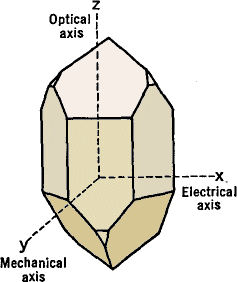| Basic Radio is a free introductory textbook on electronics based on tubes. See the editorial for more information.... |

|

Home  Oscillators Oscillators  Crystals for Oscillators Crystals for Oscillators |
|||||||||||||||||||||
| See also: Crystal Resonators, A Simple Crystal Oscillator, Crystal Oscillators | |||||||||||||||||||||






|
|||||||||||||||||||||
|
Crystals for OscillatorsAuthor: J.B. Hoag
The frequency at which the crystals vibrate depends mainly upon the thickness of the cut, being inversely proportional to the thickness. Thus we may write, f = k/t, where f is the frequency in MHz and t is the thickness of the crystal in thousandths of an inch. Values of the constant k are given in Table 29 A.
The crystal is placed between two metal plates. In one case the upper plate is pressed lightly against the upper surface of the crystal by means of a spring. In another case, a small air-gap is left between the metal plate and the crystal. In both cases, the metal plates must be quite flat. The pressure type of mounting offers greater rigidity, and hence may be used for portable or mobile installations. The air-gap mounting, however, can be used to advantage to change the frequency of oscillation over a limited range (about 5 kHz for a 3.5 MHz crystal) by changing the length of the air-gap. This does not mean that the crystal itself has a different frequency of vibration, but that the crystal, together with the small series capacitance of the air-gap, has a slightly different frequency of vibration. If the crystal vibrates with too great an amplitude, it will crack. The safe amount of radio frequency current which can pass through the crystal ranges from 50 to 200 milliamperes, depending upon the type of cut. Small flashlight bulbs can be used in series with the crystal, their brightness indicating the r.f. current. And, by proper choice of the bulb, it can be used as a fuse, burning out before the crystal is damaged. Quartz crystals have two, and sometimes three, widely separated possible frequencies of vibration. By utilizing the different modes of vibration, different crystals can be manufactured to oscillate at different frequencies throughout the range from 16 kHz to 30 MHz. For example, at the lower frequencies, say from 16 kHz to 250 kHz, the crystals are cut as " bars," whose frequency of oscillations is largely determined by the length rather than the breadth or thickness. The bars are usually mounted upon knife edges located at the nodal points of vibration. For the very high frequencies, the crystals would be exceedingly thin and fragile unless special cuts were used or the circuits were made to oscillate at harmonic frequencies of the crystal.
|
|||||||||||||||||||||
Home  Oscillators Oscillators  Crystals for Oscillators Crystals for Oscillators |
|||||||||||||||||||||
Last Update: 2009-11-01



